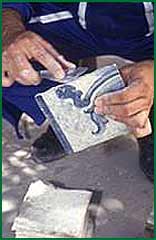| 
These
tiles presumably dated from the 17th century, were removed in time from
the stairs ornamental wainscot of one of the many old buildings being
demolished in Lisbon.
The removal of this type of tiles when they
are going to be used again must follow some techniques, that due to their
complexity should be performed by qualified technicians, in order to avoid
irreversible accidents. This type of tiles although they often present
some pathologies, can be removed, renovated and recuperated, the latest
technique difficulty depending on the support and its laying mortar. Being
thus possible to relay them on the same place or on a totally different
place, and continue to perform their function.
In this case we used this tile panel to decorate
the dining room of a Marquis of Pombal building we renovated in Lisbon.
After estimating the new areas to cover we concluded there were not sufficient
tiles and that it was necessary to produce new ones of rough material
and similar shape as the original tiles, always in accordance to what
is written and agreed upon in the Letter of Venice.
Details
of the cleaning of mortars from the tiles unhewn inner side after
being removed. This process, due to the fragility of the tiles, requires
a great deal of effort and patience so as to obtain a clean rough
material without dry mortar that will make it impossible to relay
them again.

|
|
 |
| Afterwards
it is necessary to pack the removed and cleaned tiles, and wooden
boxes adapted to the type of tiles are built allowing safe packing
and avoiding spaces in between and possible vibrations that could
damage the glazing and the rough material. |
 |
|

